Key takeaways:
- A vast majority of LED flashlights produced today use li-ion batteries.
- Reading an Li-ion battery: The first two numbers represent the diameter of the battery in mm, the next two numbers represent the battery length in millimeters, the final digit represents the shape of the battery.
- Specifications to consider: Capacity, Voltage, and Current.
- There are special Li-ion batteries that have different functions and can be denoted in the name.
Why use li-ion batteries in your flashlight?
If you’re new to LED flashlights, you may be wondering why it seems like every flashlight these days uses li-ion cells. Although flashlights, lanterns and headlamps are still made that can run on the more commonly sourced AA or AAA cells, the days of the C and D cell flashlight are rapidly dwindling.
The truth is modern LED flashlights require a more sophisticated power solution to reach the highest lumen outputs. A vast majority of LED flashlights produced today use li-ion batteries not only for their bright potential, but to also keep devices slim and lightweight. When you consider the rechargeable nature of these li-ion batteries, it’s easy to understand why li-ion batteries are preferred for high power flashlights.
How to read the names on li-ion batteries

18650, 14500, 21650 … what? These numbers may seem random, but there’s actually a method to the madness. Li-ion batteries are named with a specific convention that tells us the exact dimensions of the battery so we’ll know if it will fit into our flashlight or not. Li-ion battery names break down into three parts.
The first two numbers represent the diameter of the battery in mm. So an 18650 battery is 18 mm in diameter and a 16340 battery is, you guessed it, 16 mm in diameter.
The next two numbers represent the battery length in millimeters. Going back to the 18650 example, the middle two numbers tell us the battery is 65 mm long and a 16340 battery is 34 mm long.
You’ll notice the last number on all cylindrical batteries is always a zero. This is because the final digit represents the shape of the battery and tells us it’s round!
What about CR123 and RCR123 batteries?
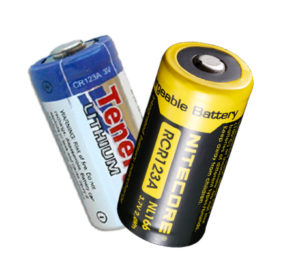
CR123, RCR123 both refer to a 16340 size battery with a few key differences.
A CR123 is the non-rechargeable lithium-manganese version of a 16340 size battery while an RCR123 is the rechargeable lithium-ion counterpart.
You may have also noticed that two 16340 batteries is roughly double the length of an 18650 battery. Many times you’ll see a flashlight support either 1x 18650 battery or 2x CR123/RCR123 batteries. Even though the 16340 batteries are slightly narrower in diameter, the length allows for a proper contact and can be substituted.
Flat-top vs. button-top
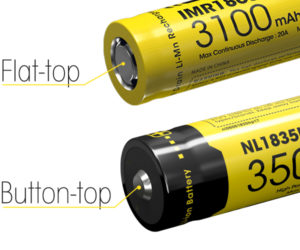
Some 18650 batteries come with a protective button on the positive pole. Button-top, or protected cells, use this little cap as an additional protection against short circuits and over discharging. Flat-top, or unprotected cells, do not have this additional safety feature and are often used in flashlights which require a large draw of current to sustain bright outputs.
If your device requires button-top batteries, you’ll want to make sure you purchase only button-top cells for one simple reason: flat-top batteries will often be just a little too short to make proper contact inside your device and not work!
If your device supports flat-top batteries, it’s important to remember that these cells can be depleted and enter a dormant state in which they will not recharge. If your flashlight can no longer sustain the maximum brightness or appears dim, remove the batteries and charge them as soon as possible to avoid this common mistake.
Tip: The vast majority of li-ion batteries we carry on our site are button-top. If you're looking for flat-top cells for vaping, we recommend our IMR 18650 3100mAh rechargeable li-ion batteries available in a 2-pack.
Understanding battery specifications
Now that we have the right size battery for our flashlight picked out, let’s look a little closer at some different specifications you might see.
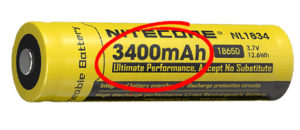
Battery Capacity
Just like li-ion batteries can come in a variety of physical sizes, there is also a range of battery capacities available. A battery capacity, labeled in milliamp hours or mAh, clues us in to how much charge the battery can hold. What this means for you is the larger the capacity of the battery, the longer runtime you’ll get on a single charge.
For the highest capacity, try: NITECORE NL1840HP 18650 li-ion battery
For the budget friendly, try: NITECORE NL1823 18650 li-ion battery
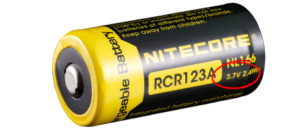
Battery Voltage
Voltage lets you know the electronic potential of the battery, or in simpler terms, how strong the electric current is when discharged from the battery. Most li-ion batteries have a low voltage between 3 and 3.7V.
One word of caution: When two batteries are placed in a series, the voltage of each battery is combined to calculate the new total voltage. This means that although many flashlights can swap between 1x 18650 or 2x 16340 batteries, some devices will not be able to handle the extra voltage. Always follow the manufacturer’s recommendations to avoid frying your flashlight with too high a voltage.
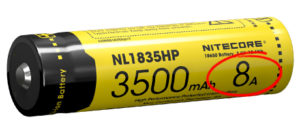
Battery Output Current
While voltage tells us the strength of the battery output, we also need to know how much electrical current is flowing at a given time. For this we can look at a battery’s discharge rate which is measured in amps or A.
A standard, button-top 18650 battery will usually have a discharge rate around 5A (or often not list the discharge rate at all!). As advances in LED technology have demanded higher and higher outputs, nowadays you’ll see some flashlights like the MT1A Pro, MH10 v2 and HC33 require a high discharge rate to enable the brightest modes. If this is the case for your flashlight, you’ll want to seek out batteries that meet the minimum discharge rate specified by the manufacturer.
IMR batteries: It’s all about chemistry
But what about IMR batteries, you ask? What’s the difference between a li-ion and an IMR battery? Li-ion is a general term referring to any battery that uses lithium ions to create an electrical current.
More specifically, IMR batteries are a type of li-ion battery that uses manganese as the primary cathode material. Usually seen in flat-top cells, this chemistry is preferred and sometimes required for high drain devices.
Specialty li-ion batteries and when you’ll want them
With more advances in battery technology, the more options have become available to consumers. Below we cover two of the most recent advances and when you'll want to pick up a pair.
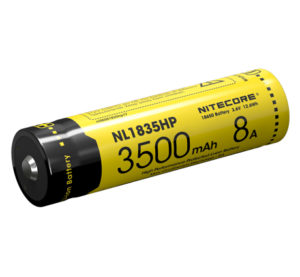
High performance
As mentioned above, some flashlights need li-ion batteries with a high discharge rate in order to reach the brightest outputs. In the past, your only option was often a flat-top IMR battery more commonly used in vaping devices. This is an okay solution, but what if you want a protected cell?
To meet the growing demand, NITECORE has created a line of High Performance (HP) batteries designed to meet high discharge needs in a button-top battery. These li-ion batteries such as the NL1840HP feature an 8A discharge rate and are a must for any NITECORE flashlight requiring a high discharge battery.
One final reason not to shy away from High Performance li-ion batteries: they’re backwards compatible! If you have an older LED flashlight that runs on regular old 18650s, you can still use HP batteries without worrying about the higher discharge rate affecting your device. We frequently recommend these batteries to anyone who currently owns an older model but thinks they might upgrade in the future to one of our high performance flashlights.
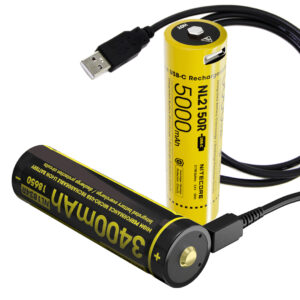
USB Rechargeable
One of the newest advances in li-ion batteries is the introduction of USB rechargeable batteries. That's right, these cells come with a micro-USB port built directly into the battery!
If you're looking to minimize your carry or want to supplement a flashlight that doesn't have a built-in charging port, these batteries are for you. Compatible with common USB power sources such as power banks, solar panels and laptops (and traditional chargers, too!), all you need to do is plug these batteries in to charge. An indicator light underneath the positive pole goes from red to green to indicate charging progress.
For the highest capacity, try: NITECORE NL1836R 3600mAh USB rechargeable li-ion battery
For the budget friendly, try: NITECORE NL1826R 2600mAh USB rechargeable li-ion battery
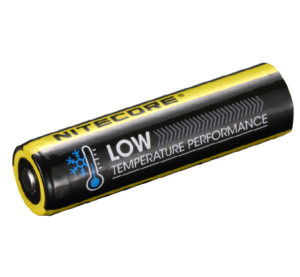
Low temperature
If you plan on using your flashlight in cold temperatures (think sub-zero), you might want to consider picking up batteries designated for use in low temperatures. Designated as LT in their model names, these batteries are optimized for, you guessed it, low temps.
In the past, CR123A batteries were the preferred power source for anything in cold weather due to their chemistry’s superior performance. Now, NITECORE makes the NL1835LTHP low temp, high-performance battery and the NL2142LTP low temp battery -- all designed to perform in temperatures all the way down to -40 F.


Why invent completely contrived and utterly idiotic new designations for battery sizes when the whole world is happy to use AA, AAA, C, D, etc?
Your chargers might be good, but for batteries I’ll stick with the proven technology, sizes and quality of eneloop, rayovac, duracell or ebl.
Hi Peter,
We understand the naming convention is different than what many people are used to and seems arbitrary at first. Just to clarify, these sizes are not made up by NITECORE, but follow common designations used by all li-ion battery manufacturers and are based on the actual dimensions of the battery.
Wow you must think the metric system is stupid too.
Let me know when you find an 18650 with those other brands of the energy density of lithium.
Eneloops have their place, I have about 60 of them. Haven’t purchased an alkaline battery in a decade.
The 18650 is the foundation for many new devices from Dyson vacuums being able to have corded vacuum performance to electric vehicles. There’s a reason they don’t use D cells or Nimh in those applications.
I’ll take these Nitecore “weird named” batteries over Duracell, Rayovac, or Energizer AAs and AAAs ANY DAY!! These batteries are TOP quality and have been trueley reliable compared to my lights running normal AAs/AAAs or even rechargeable AAs/AAAs. For people who work in public safety, rely on their light on backwoods adventures, or need a light they know will work, Nitecore makes top of the line batteries!!
Also, you know how a lot companies use CR123 batteries in their lights? Well, they are EXPENSIVE and some high output lights get 18mins out of the CR123s when in high mode. So, Nitecore 18650s come along and honestly make owning a CR123 x 2 battery high performance light bearable!! I say this because I can’t tell you how much $$ I’ve spent over the years buying large packs of SureFire CR123s that cost AT LEAST $8 for 2 CR123s ($32 minimum to get a 8pack). The $8 in CR123s get you one night of use if you’re using your light for hours, if you’re lucky. So, a weekend in the woods may end up costing you $50 in batteries that just fill landfills or need recycled. Then comes NITECORE 18650s, 1 18650 replaces 2 CR123s, AND THEY CAN BE USED OVER AND OVER AGAIN!! They have technology inside the battery that avoids damaging your light OR you’re batteries. They can be purchased for $8-$25 each and end up saving you SO MUCH MONEY over time!!
Just my two cents because I used to hate non AA/AAA flashlights, but after using all different types, the performance from these “weird” batteries just blows them away, but they also make sense financially and make sense in regards to waste and efficiency. NITECORE makes AWESOME versions of the batteries and I run them when I need to make sure my shit works!! Oh yeah, NITECORE chargers are also so much better than the ones I bought from others. They actually keep the batteries healthy, extend their life, and keep things safe since Li-Ion batteries can be dangerous if your charger or battery doesn’t have built in technology to manage the health of the cells and prevent over charging (they make BIG fire balls when things go wrong!!).
Does Nitecore make High Performance batteries in AA or AAA or D size?
Hi Neil, No NITECORE does not. High performance is a special designation for our 18650 li-ion batteries with an 8A output.
is there a nitcore rechargable battery that can replace Alkaline AA?
Although we do offer batteries that are equivalent in size to AA alkaline batteries (14500), it would depend on your device as to whether or not these batteries would be supported. Most AA alkaline batteries have a nominal 1.5V whereas our 14500 li-ion batteries are rated at 3.6 or 3.7V. Unless you’re confident your device can handle the doubled voltage, it is not recommended using our batteries in place of AA alkaline batteries.
For a rechargeable option, you might want to look at these rechargeable AA Ni-MH batteries we carry instead. Although not NITECORE brand, these offer a quality rechargeable option at only 1.2V which would make them compatible with traditional AA devices.
Could you comment on LiFePo4 batteries. Are any of them usable in flashlights that normally use lithium ion cells? They seem to offer similar voltage and capacity, but have a longer life. Information on them is hard to come by.
Hi Marvin,
For battery compatibility, please refer to the user manual or manufacturer of your flashlight.
Just bought two Nitecore 1835HP. They eont work in my Zebralight headlamp. All of my other 18650 batteries work just fine in the same headlamp. What could be wrong?
Thanks for explaining how a battery’s discharge rate should be measured in amps that can tell us how much electrical current is flowing at any given time. My dad has been thinking about getting some big batteries that he can store some extra energy in. Getting them from a professional could ensure that he can get the right kind of size that they need.